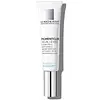What's inside
What's inside
 Key Ingredients
Key Ingredients

 Benefits
Benefits

 Concerns
Concerns

 Ingredients Side-by-side
Ingredients Side-by-side

Water
Skin ConditioningGlycerin
HumectantButylene Glycol
HumectantDimethicone
EmollientNiacinamide
SmoothingIsopropyl Palmitate
EmollientCetearyl Alcohol
EmollientAmmonium Polyacryloyldimethyl Taurate
Emulsion StabilisingButyrospermum Parkii Butter
Skin ConditioningPEG-100 Stearate
PEG/PPG/Polybutylene Glycol-8/5/3 Glycerin
HumectantStearic Acid
CleansingGlyceryl Stearate
EmollientDimethicone/Vinyl Dimethicone Crosspolymer
Skin ConditioningDimethiconol
EmollientCaffeine
Skin ConditioningSodium Hydroxide
BufferingSilica
AbrasiveGinkgo Biloba Leaf Extract
Skin ConditioningPalmitic Acid
EmollientAlumina
AbrasivePhenylethyl Resorcinol
AntioxidantAscorbyl Glucoside
AntioxidantPoloxamer 338
EmulsifyingDisodium EDTA
Isopropyl Titanium Triisostearate
EmollientHydrolyzed Rice Protein
Skin ConditioningCaprylyl Glycol
EmollientXanthan Gum
EmulsifyingFerulic Acid
AntimicrobialPhenoxyethanol
PreservativeCI 77491
Cosmetic ColorantCI 77492
Cosmetic ColorantCI 77499
Cosmetic ColorantCI 77891
Cosmetic ColorantMica
Cosmetic ColorantWater, Glycerin, Butylene Glycol, Dimethicone, Niacinamide, Isopropyl Palmitate, Cetearyl Alcohol, Ammonium Polyacryloyldimethyl Taurate, Butyrospermum Parkii Butter, PEG-100 Stearate, PEG/PPG/Polybutylene Glycol-8/5/3 Glycerin, Stearic Acid, Glyceryl Stearate, Dimethicone/Vinyl Dimethicone Crosspolymer, Dimethiconol, Caffeine, Sodium Hydroxide, Silica, Ginkgo Biloba Leaf Extract, Palmitic Acid, Alumina, Phenylethyl Resorcinol, Ascorbyl Glucoside, Poloxamer 338, Disodium EDTA, Isopropyl Titanium Triisostearate, Hydrolyzed Rice Protein, Caprylyl Glycol, Xanthan Gum, Ferulic Acid, Phenoxyethanol, CI 77491, CI 77492, CI 77499, CI 77891, Mica
Water
Skin ConditioningPropanediol
SolventPolymethylsilsesquioxane
Hexylene Glycol
EmulsifyingSodium Polyacrylate
AbsorbentGlycerin
HumectantDimethyl Isosorbide
SolventPentylene Glycol
Skin ConditioningAminopropyl Ascorbyl Phosphate
AntioxidantPsidium Guajava Leaf Extract
AstringentSaccharomyces Lysate Extract
HumectantJasminum Sambac Flower Extract
MaskingCrataegus Monogyna Flower Extract
Skin ConditioningChrysin
Skin ConditioningN-Hydroxysuccinimide
Skin ConditioningPalmitoyl Tripeptide-1
Skin ConditioningPalmitoyl Tetrapeptide-7
Skin ConditioningAcetyl Hexapeptide-8
HumectantMyristyl Nicotinate
Skin ConditioningAdenosine
Skin ConditioningBacillus/Sea Salt Ferment Filtrate
Skin ConditioningWithania Somnifera Root Extract
Skin ConditioningCamellia Sinensis Leaf Extract
AntimicrobialAstaxanthin
Skin ConditioningAcacia Senegal Gum
MaskingHydrolyzed Rhizobian Gum
Tetrasodium Glutamate Diacetate
Steareth-20
CleansingEthylhexylglycerin
Skin ConditioningPhloretin
AntioxidantCaprylyl Glycol
EmollientZinc PCA
HumectantChlorhexidine Digluconate
AntimicrobialSilica
AbrasiveBiotin
AntiseborrhoeicSodium Citrate
BufferingCitric Acid
BufferingAscorbic Acid
AntioxidantSodium Starch Octenylsuccinate
AbsorbentCyclodextrin
AbsorbentPhenoxyethanol
PreservativeSodium Benzoate
MaskingPotassium Sorbate
PreservativeSodium Hydroxide
BufferingWater, Propanediol, Polymethylsilsesquioxane, Hexylene Glycol, Sodium Polyacrylate, Glycerin, Dimethyl Isosorbide, Pentylene Glycol, Aminopropyl Ascorbyl Phosphate, Psidium Guajava Leaf Extract, Saccharomyces Lysate Extract, Jasminum Sambac Flower Extract, Crataegus Monogyna Flower Extract, Chrysin, N-Hydroxysuccinimide, Palmitoyl Tripeptide-1, Palmitoyl Tetrapeptide-7, Acetyl Hexapeptide-8, Myristyl Nicotinate, Adenosine, Bacillus/Sea Salt Ferment Filtrate, Withania Somnifera Root Extract, Camellia Sinensis Leaf Extract, Astaxanthin, Acacia Senegal Gum, Hydrolyzed Rhizobian Gum, Tetrasodium Glutamate Diacetate, Steareth-20, Ethylhexylglycerin, Phloretin, Caprylyl Glycol, Zinc PCA, Chlorhexidine Digluconate, Silica, Biotin, Sodium Citrate, Citric Acid, Ascorbic Acid, Sodium Starch Octenylsuccinate, Cyclodextrin, Phenoxyethanol, Sodium Benzoate, Potassium Sorbate, Sodium Hydroxide
 Reviews
Reviews

Ingredients Explained
These ingredients are found in both products.
Ingredients higher up in an ingredient list are typically present in a larger amount.
Caprylyl Glycol is a humectant and emollient, meaning it attracts and preserves moisture.
It is a common ingredient in many products, especially those designed to hydrate skin. The primary benefits are retaining moisture, skin softening, and promoting a healthy skin barrier.
Though Caprylyl Glycol is an alcohol derived from fatty acids, it is not the kind that can dry out skin.
This ingredient is also used as a preservative to extend the life of products. It has slight antimicrobial properties.
Learn more about Caprylyl GlycolGlycerin is already naturally found in your skin. It helps moisturize and protect your skin.
A study from 2016 found glycerin to be more effective as a humectant than AHAs and hyaluronic acid.
As a humectant, it helps the skin stay hydrated by pulling moisture to your skin. The low molecular weight of glycerin allows it to pull moisture into the deeper layers of your skin.
Hydrated skin improves your skin barrier; Your skin barrier helps protect against irritants and bacteria.
Glycerin has also been found to have antimicrobial and antiviral properties. Due to these properties, glycerin is often used in wound and burn treatments.
In cosmetics, glycerin is usually derived from plants such as soybean or palm. However, it can also be sourced from animals, such as tallow or animal fat.
This ingredient is organic, colorless, odorless, and non-toxic.
Glycerin is the name for this ingredient in American English. British English uses Glycerol/Glycerine.
Learn more about GlycerinPhenoxyethanol is a preservative that has germicide, antimicrobial, and aromatic properties. Studies show that phenoxyethanol can prevent microbial growth. By itself, it has a scent that is similar to that of a rose.
It's often used in formulations along with Caprylyl Glycol to preserve the shelf life of products.
Silica, also known as silicon dioxide, is a naturally occurring mineral. It is used as a fine, spherical, and porous powder in cosmetics.
Though it has exfoliant properties, the function of silica varies depending on the product.
The unique structure of silica enhances the spreadability and adds smoothness, making it a great texture enhancer.
It is also used as an active carrier, emulsifier, and mattifier due to its ability to absorb excess oil.
In some products, tiny microneedles called spicules are made from silica or hydrolyzed sponge. When you rub them in, they lightly polish away dead skin layers and enhance the penetration of active ingredients.
Learn more about SilicaSodium Hydroxide is also known as lye or caustic soda. It is used to adjust the pH of products; many ingredients require a specific pH to be effective.
In small amounts, sodium hydroxide is considered safe to use. However, large amounts may cause chemical burns due to its high alkaline.
Your skin has a natural pH and acid mantle. This acid mantle helps prevent harmful bacteria from breaking through. The acid mantle also helps keep your skin hydrated.
"Alkaline" refers to a high pH level. A low pH level would be considered acidic.
Learn more about Sodium HydroxideWater. It's the most common cosmetic ingredient of all. You'll usually see it at the top of ingredient lists, meaning that it makes up the largest part of the product.
So why is it so popular? Water most often acts as a solvent - this means that it helps dissolve other ingredients into the formulation.
You'll also recognize water as that liquid we all need to stay alive. If you see this, drink a glass of water. Stay hydrated!
Learn more about Water